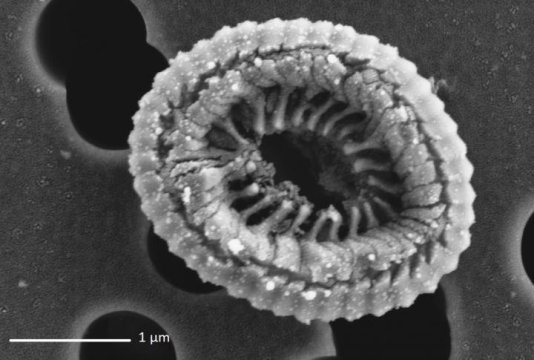[ad_1]
Microscopic plant-like organisms called phytoplankton are known to support the diversity of life in the ocean. Scientists in Israel now report that one species, Emiliania huxleyi, and a virus closely associated with it, might be responsible for changes in cloud properties as well. When infected, E. huxleyi releases its chalky shell into the air, where it acts as an aerosol reflecting sunlight and even affecting cloud creation and movement. The research appears August 15 in the journal iScience.
“Our aim is to better understand the effects that marine ecology can have on atmospheric properties like radiation and cloud formation,” says first author Miri Trainic, an Earth scientist at the Weizmann Institute of Science. “This slim air-sea interface controls fluxes of energy, particles, and gases, so if we want to understand climate and climate change, we must understand how microscopic biological activity in the ocean alters this balance.”
When the virus EhV infects E. huxleyi it forces the phytoplankton to emit bits of its shell into the air. When released, these shells, which are made of chalky calcium carbonate, become part of a class of marine emissions called sea spray aerosols (SSAs). “SSAs are particles emitted into the atmosphere when bubbles in the ocean burst,” says Ilan Koren, an atmospheric scientist also at the Weizmann. “They cover 70% of the atmosphere and can serve as cloud condensation nuclei, be surfaces for chemical reactions, and significantly contribute to the Earth radiation budget (the balance of how much solar energy Earth absorbs and how much it emits back into space) because they are very reflective.”
When observing a model system in the lab, the researchers found the volume of E. huxleyi SSA emissions to surpass anything they expected and the size of the particles themselves to be far larger than they had predicted. More numerous and larger particles will cumulatively be much more reflective than the researchers had anticipated and can strongly influence other cloud properties.
“Although E. huxleyi is extremely abundant, responsible for algal blooms covering thousands of kilometers, we didn’t expect to measure such a large flux of SSAs emitted from them into the air. Plus, we expected no larger than a 1-micron diameter but measured 3 and 4 microns,” says Trainic. “Before this work, we didn’t know that such large particles would be so abundant in the marine-atmospheric size distribution.”
The researchers were also surprised by the SSAs’ complex structure and its effects on aerodynamics. “What we found was that we don’t need to look at just the size of the SSA, but also its density,” says Assaf Vardi (@vardilab), an environmental scientist at the Weizmann. “These ones are shaped like parachutes; they have an intricate structure of calcium carbonate with lots of space within it, which extends the particle’s lifetime in the atmosphere.”
From here, the researchers will venture to places like Norway to observe these blooms and their SSA emissions in the natural world. “This study focuses on one species and its virus, but in a broader context it can show that the state of the atmosphere actually depends on the daily interactions in the seawater,” Trainic says. “Now we must do our best to further understand that relationship.”
Story Source:
Materials provided by Cell Press. Note: Content may be edited for style and length.
[ad_2]















